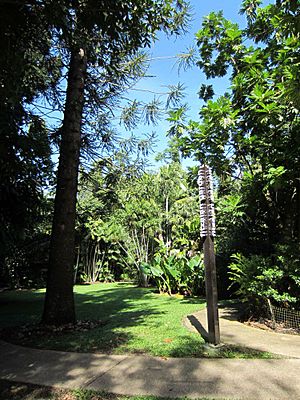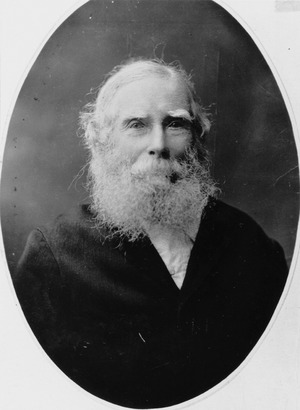Flecker Botanical Gardens facts for kids
Quick facts for kids Flecker Botanical GardensAKA Cairns Botanic Gardens |
|
|---|---|

Fleckers Botanic Gardens, 2015
|
|
| Location | Collins Avenue, Edge Hill, Cairns, Cairns Region, Queensland, Australia |
| Design period | 1870s - 1890s (late 19th century) |
| Built | 1886 - 1960s |
| Official name: Flecker Botanical Gardens, Cairns Botanic Gardens, Edge Hill Nursery, Fitzalan's Botanical Gardens | |
| Type | state heritage (landscape, built) |
| Designated | 2 February 2007 |
| Reference no. | 602541 |
| Significant period | 1880s-1982 (fabric) 1880s-1960s (historical) 1880s - (social) |
| Significant components | natural landscape, bridge - foot/pedestrian, paving, wall/s - retaining, gate - entrance, office/administration building, garden - layout, fernery, pathway/walkway, garden - rainforest, trees/plantings, lawn/s, garden - bed/s, road/roadway |
| Lua error in Module:Location_map at line 420: attempt to index field 'wikibase' (a nil value). | |
The Flecker Botanical Gardens is a special place in Cairns, Queensland, Australia. It's also known as the Cairns Botanic Gardens. This amazing garden is listed on the Queensland Heritage Register because of its important history and beautiful plants.
It was first started in the mid-1880s as a recreation area. Over the years, many people helped it grow into the wonderful botanic garden it is today. It's a great spot to learn about plants and enjoy nature.
Contents
Discovering the History of Cairns Gardens
The Flecker Botanic Gardens started around 1886. This was just ten years after the town of Cairns was first mapped out. Cairns was a port for gold miners back then.
The garden is located south of Mount Islay. It was originally part of a larger recreation area. Even though it wasn't officially called a "botanic garden" at first, it quickly became one.
Early Days and Eugene Fitzalan's Vision
In 1884, people in Cairns wanted a botanic garden. Botanic gardens were important places in the 1800s. They were used for fun, to save local plants, and to grow useful plants from other countries.
In 1886, a large area of land was set aside for recreation. This land included parts of Mount Islay and a swamp. It was about 3 miles from the center of Cairns. A new railway line nearby made it easy for people to visit.
In December 1886, the Cairns Council hired Eugene Fitzalan. He was a trained botanist. His job was to create a beautiful garden that people would want to visit. He was also allowed to sell drinks and run his own plant nursery.
Fitzalan was born in Ireland in 1830. He collected plants in England and Mexico before coming to Australia. He loved collecting orchids. He even had orchids named after him by a famous botanist, Baron von Mueller.
Fitzalan created a garden of about 5 acres. It was called Rosebank or Fitzalan's Botanical Gardens. He planted colorful garden beds and built a fence. He also built a small house and a nursery shed.
He made a main path, about 9 feet wide, through the reserve. He planted special trees along this path. This path later became Collins Avenue. He also made other paths, including a circular walking track through the rainforest.
Fitzalan grew many plants, including 50 types of roses and 11 types of hibiscus. He also grew coffee, oranges, lemons, and mangoes. He sent many orchids and palms to Europe. He stopped working in 1897 due to poor health.
The Gardens in the 20th Century
After Fitzalan, other curators looked after the garden. In 1906, the Cairns Council Nursery was set up. This nursery grew plants for the town's needs.
In 1921, the recreation area became a permanent reserve. It was managed by the Cairns Town Council. Les Wright became the Council's nurseryman in 1923. He worked there until 1947.
Dr. Hugo Flecker's Contributions
In the 1930s, people wanted a formal botanic garden. Dr. Hugo Flecker (1884-1957) was a big part of this. He was a doctor who loved nature. He founded the North Queensland Naturalist Club in 1932.
Dr. Flecker studied poisonous plants and animals. He even identified the deadly box jellyfish, Chironex fleckeri. He wrote a weekly newspaper column to encourage the creation of a botanic garden.
In 1933, Dr. Flecker started a plant collection (herbarium) at the council's nursery. This collection grew to over 10,000 plant specimens. It was very popular with visitors.
Developing the Gardens and Zoo
Between 1934 and 1935, about 25 acres of the reserve were cleared. Young trees were planted to create beautiful avenues. This project continued until 1940.
In 1936, the Cairns City Council added a small zoo to the reserve. It had native birds and animals. This made the gardens even more popular, especially with soldiers during World War II. The zoo closed in 1953.
After Les Wright, Tom Mitchell became the curator. A red brick house was built for him in the 1950s. This house is now the garden's information center.
Modern Development and Recognition
In 1966, Vince Winkel became the Curator. He designed a new botanic garden area. He created a figure-of-eight walkway. A small creek runs through it, with a bridge crossing it.
The paths were made with bricks and concrete. Retaining walls were built using river stones. The walking areas were made non-slip with special concrete.
The Fernery and Orchid House
A special fernery was built in 1968. It housed a collection of ferns from the Munro-Martin family. It had a small waterfall and a pond. Near the fernery was the Curator's office and a picnic area.
In 1971, the Cairns City Council named the new garden the Flecker Botanic Gardens. This was to honor Dr. Flecker's work. The name now applies to the whole recreation area.
At this time, the gardens had over 100 types of native orchids and over 100 types of palms. They also had plants like coffee, tea, cocoa, and ginger. A very large Rain Tree from South America was also there.
In 1974, the Flecker Botanic Gardens was listed in the International Directory of Botanical Gardens. This showed its importance worldwide. The gardens are known for their amazing collection of ferns.
The gardens also exchanged plants with other countries. Aviaries were added in 1974 for pheasants and peacocks. A tree house was added to the children's playground.
In 1982, new entrance gates were built. They celebrated 50 years of the North Queensland Naturalists' Club.
Challenges and Growth
Nature can be tough on gardens. In 1986, Cyclone Winifred caused a lot of damage. Many old trees were badly hurt.
After the cyclone, a plan was made to improve the gardens. This included fixing the fernery and adding Braille labels to trees. A restaurant was built in 1987. The gardens became very popular, with 100,000 visitors each year.
In 1989, the "Friends of the Botanical Gardens" group was formed. They helped raise awareness. In the 1990s, the gardens focused on education. They offered guided walks and started an annual festival.
Today, Flecker Botanic Gardens continues its important work. It collects endangered plants from the Wet Tropics World Heritage Area. It also helps with scientific research around the world. The garden is famous for its collections of palms, gingers, and aroids.
Exploring the Gardens Today
The Flecker Botanic Gardens is bordered by Collins Avenue, McCormack, Goodwin, and MacDonnell streets. When you visit, you'll see many different types of plants.
Near Collins Avenue and McCormack Street, there are large hoop pines, a Cook pine, and a sausage tree. These types of trees were often planted in old botanic gardens.
Further north, you can find a very large rain tree. There are also blue quandongs, damson plums, and bamboo. You'll also see mature mango trees.
Rainforest plants grow along the creek banks and paths. The 1960s figure-of-eight walkway is still there. You'll cross Fitzalan Creek using two footbridges. The paving in the southern part of the gully is the oldest. It uses bricks and concrete.
The retaining walls are made from different materials. Some are logs, others are concrete. The paths are made non-slip with small, smooth pebbles.
The plants in the Fitzalan Creek gully have changed over time. Today, you'll see many aroids, gingers, and Asian plants. The lower part of the gully has large paperbark trees, damson plums, and Leichhardt trees.
There are three open lawn areas in the gardens. One is near the main entrance. Another is a large space for outdoor shows. The third is a long, tree-lined area along Goodwin Street. The main lawn has a large teak tree planted in 1946.
Along MacDonnell Street, there are very old and large trees. These include a Bayur tree, a mock orange, a Cassia javanica, and a Tar tree. These trees might have been part of the very first plantings.
The buildings in the gardens are designed to blend in. The 1968 Munro-Martin Fernery has a metal frame and shade cloth. The George Watkins Orchid House (1986) is next to it. Neither of these buildings is considered historically significant.
The entrance gates (1982) are made of decorative stonework. Other buildings, like the red brick curator's office (1950s) and the restaurant (1987), are hidden by the plants. Their placement makes them blend into the landscape.
Why the Gardens are Special
The Flecker Botanical Gardens is listed on the Queensland Heritage Register for several reasons:
- It shows how Queensland's history has changed: The gardens show how botanic gardens have developed in regional cities. Since the 1930s, it has helped us learn about local plants and their uses. It shares this knowledge with other gardens worldwide. It also provides a fun and educational place for people to visit.
- It shows what a wet tropics botanic garden is like: The gardens show the main features of a large botanic garden in a wet, tropical area. This includes old plantings and the display garden designed in the 1960s. It also includes the paths, walls, bridges, and special plant displays.
- It is beautiful: The gardens have a lush, tropical feel. Large trees, both native and from other places, create a beautiful structure. Colorful orchids, gingers, and ferns grow underneath. The natural hills, creek, and swamp have been used well in the design. The garden feels like it grew from nature, rather than being forced. This makes it a charming place to visit.
- It is connected to important people and groups: The gardens are strongly linked to Dr. Hugo Flecker. He started the North Queensland Naturalist Club in 1932. His large plant collection was kept at the gardens for many years. The gardens also have a special connection with the Cairns City Council. The Council has helped develop and promote the gardens as a place for fun and learning. Since the 1960s, it has been known worldwide for its scientific work in Australia's wet tropics.
Images for kids




